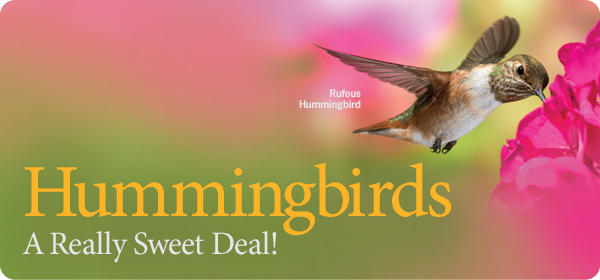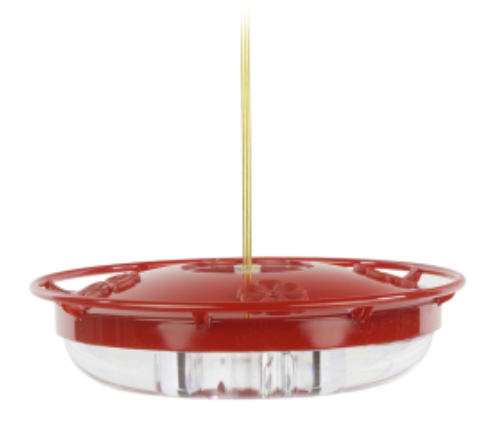
Hummingbirds - Too Good to Be True!
Hummingbirds – Where do you start? So cool! So tiny! So unique! Certainly one of the most beautiful birds in the world and truly one of the most fascinating.
What makes them so special?
Size for one…or the lack there-of. They really are the smallest of all birds, and yet, with more than 330 species, they are the second largest family of birds in the world. A fact made even more remarkable when considering that they are found no where else on the planet except in the Americas. Not in Asia, not in Europe, not in Africa or anywhere else except the Western Hemisphere.
They are the undisputed avian aerobatic flight champions, masters at hovering and the only birds able to fly backwards and upside down.
They have the fastest heart rate, the fastest wing beat, the fastest metabolism and the largest heart, in proportion to body size, of any bird.
A large heart, but a really small brain, the smallest of any bird…about the size of a BB! But it’s a good brain, capable of navigating thousands of miles to migrate back to the exact same feeder year after year.
And the smallest of all birds has one of the biggest appetites…ingesting up to eight times their weight in solid food and liquid every day.
As for that “solid” food…they use the flexible tip of their bill to capture insects and insect eggs from the ground and on plants. They love spiders and spider eggs. And as for the “liquid” portion, their forked, open-grooved tongues lap up nectar from the feeders and flowers at an amazing 12 times a second.
We have several species of hummingbirds that visit us in Santa Fe including Black-chinned Hummingbirds and Broad-tailed Hummingbirds through the season (April-October) and Rufous Hummingbirds and Calliope Hummingbirds (June-July).
Foods
Along with nectar from native flowering plants, Hummingbirds eat insects and insect eggs on the ground and in trees. They love spiders and spider eggs. They use their bill and not their tongue to catch insects. The best way to attract hummingbirds to you backyard is to offer a combination of native nectar-producing plants, as well as nectar feeders to provide our WBU Hummingbird and Oriole Nectar or Naturally Fresh Hummingbird Nectar with Feeder Fresh Nectar Defender Liquid Concentrate. You can also create your own nectar using a 4:1 water/sugar ratio).
Some tips to remember when feeding hummingbirds:
Change the nectar and wash your feeder in hot water every three to four days (more often in hot weather).
Use Hummingbird Feeder Fresh Nectar Defender to help keep your nectar fresher longer.
If you have a WBU Hummingbird Feeder, simply place it in the top drawer of your dishwasher for easy cleaning.
If you plan to store nectar in the refrigerator, boil the water first before creating and storing your nectar solution.
Never add red food coloring, honey or artificial sweeteners to the solution.
By having a hummingbird feeder, you can provide the much-needed energy that hummingbirds require, especially during migration. Fill a hummingbird feeder with a solution of four parts water, one part table sugar. Be patient! It can take several weeks or even months for hummingbirds to find your feeders. Placing them near colorful flowers which hummingbirds favor, such as bee balm, will help to introduce them to your feeders. These birds are quite bold, too, so try placing a feeder close to the house so you can catch all the action!
Tips for Successful Hummingbird Feeder Placement:
1. Eye-catching: Position your feeder where light and reflections catch the birds' attention, ideally near foliage and inviting native flowers such as honeysuckle or beebalm.
2. Accessibility: Place the feeder where it's easy for you to refill and clean, such as near decks or patios.
3. Safety: Try suspending your feeder near bushes for perching spots and where they can be attentive to predators. Your feeder should be no more than 10-15’ from foliage. Hang the feeder high enough to prevent predators like cats from reaching it.
4. Privacy: Offer multiple feeder stations to accommodate territorial hummingbirds.
5. Proximity: Situate the feeder near windows or outdoor seating areas for optimal viewing and enjoyment.
6. Protection: Choose a location sheltered from strong winds and rain to prevent spills and spoilage of nectar.
7. Shade: Opt for spots with dappled shade to slow down nectar spoilage and maintain hummingbirds' health.
8. Spacing: Keep the area around the feeder open to accommodate hummingbirds' swift movements.
Here is one of our favorite hummingbird feeders... Come on by the store to see lots more choices and nectar too!
Medium High Perch Hummingbird Feeder
Our High Perch™ hummingbird feeder is the perfect way to attract hummingbirds to any yard. The high perch allows hummingbirds to comfortably rest, providing you with better, longer views of the birds.


